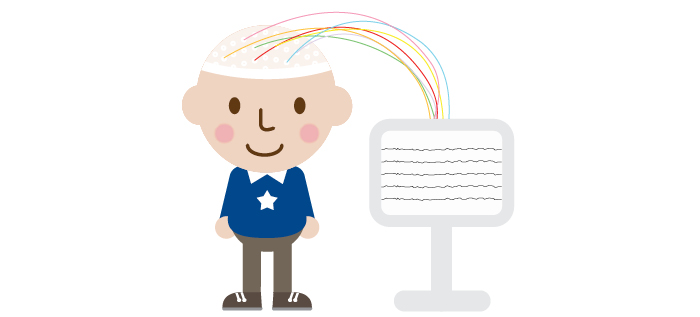EEG (Electroencephalogram)
An EEG is a short form for the word ‘electroencephalography’ (e-LEK-tro-en-SEF-uh-LOG-rah-fee). An EEG is a test that looks at the patterns and location of electrical activity in the brain. During the test, these patterns of electricity are recorded as wavy lines on a computer or on paper. This test usually takes about one hour and does not hurt.

The EEG shows patterns of normal or abnormal brain electrical activity. Some abnormal patterns may occur due to a number of different conditions, not just seizures. For example, certain types of waves may be seen after head trauma, stroke, brain tumor, or seizures. A common example of this type is called “slowing,” in which the rhythm of the brain waves is slower than would be expected for the patient’s age and level of alertness.
- Certain other patterns indicate a tendency toward seizures. Your doctor may refer to these waves as “epileptiform abnormalities” or “epilepsy waves.” They can look like spikes, sharp waves, and spike-and-wave discharges.
- If you have partial seizures, spikes and sharp waves on the EEG in a specific area of the brain, such as the temporal lobe, can show where the seizures are coming from.
- Generalized epilepsy is suggested by spike-and-wave discharges that are widely spread over both side of the brain, especially if they begin in both sides at the same time.
- Wash your hair before going to the hospital.
- Do not use any conditioner or gel on your hair.
- If your child is getting an EEG and cannot lie still for the test, they may have to have a mild sedative.
- A sedative is a medicine that will calm your child so that they can lie still.
- Before having any sedation, your child will have to be careful about what they eat or drink.
- The treatment team will tell you when your child needs to stop eating and drinking before the EEG.
- Your may have to wear hospital clothing or a gown during the EEG.
If your child did not have a sedative, she will have no side effects from the EEG. If your child had a sedative, she may be sleepy, grumpy, and unsteady for four to six hours. Please check on your child carefully for about six hours after the test.
Give your child only small sips of clear liquids such as water or apple juice. When they are fully awake, your child can have a regular meal if they feel like eating, and they can go back to their usual activities.
The clinician may ask that you be sleep-deprived before an EEG so that you will be drowsy and can fall asleep more easily during the EEG.
A Video EEG test records your brainwaves on an EEG and a video of what is going on at the same time. The purpose is to be able to see what is happening when you have a seizure or event and compare the picture to what the EEG records at the same time. Sounds that occur during the testing are also recorded – this can pick up if a person talks or makes sounds during an event. By doing this, doctors reading the EEG can tell if the seizure or event was related to the electrical activity in the brain. If so, we’d call this an epileptic seizure.
- Video-EEG is most helpful to determine if seizures with unusual features are actually epilepsy, to identify the type of seizures, and to pinpoint the region of the brain where seizures begin. Locating the region precisely is essential if epilepsy surgery is being considered.
- Other names for Video EEG tests include: EEG telemetry, EEG monitoring, or Video EEG monitoring. Usually these terms mean the same thing.
- You will generally lie comfortably on your back on a bed. In some cases, EEGs are done while you are seated.
- Your head will be measured and marked with a wax pencil so that the EEG technologist knows where to put the small gold circles called electrodes.
- The marked areas on your head will be cleaned with a special gel, which is a thick soap.
- Then electrodes will be temporarily stuck to your head with cream and gauze.
- The electrodes are hooked up to a computer with long wires.
- Sometimes the electrodes are in a rubber cap like a bathing cap.
- The computer records the patterns of electricity of your brain.
- Throughout the test, the machine makes a continuous record of your brain activity, or brainwaves, on a long strip of recording paper or on a computer screen.
During the test, the technologist may ask you to:
- breathe deeply for three minutes
- open and close your eyes
- watch a flashing bright light for a few minutes
These exercises are done to stimulate certain types of brain activity. They do not mean, for example, that flashing lights will always trigger seizures.
You may have the test while you are asleep and awake. This is done to see the differences in the brain when you are awake and asleep.
Your hair may be a little sticky from the cream. You can easily wash out the cream with shampoo.
Reprinted from Sick Kids, Elizabeth J. Donner, MD, FRCPC, 2/4/2010
